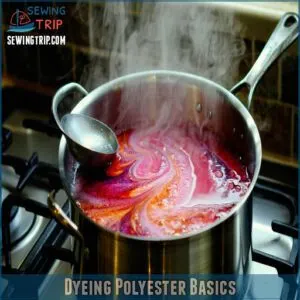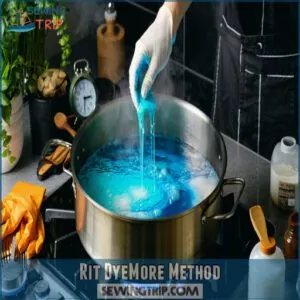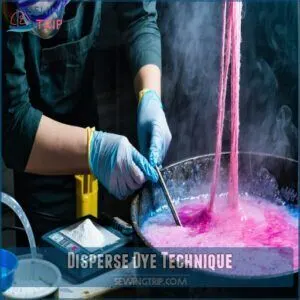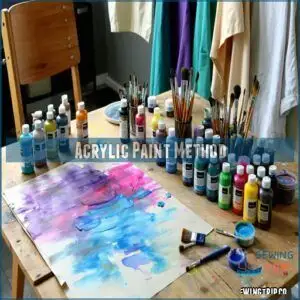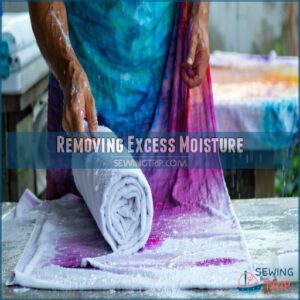This site is supported by our readers. We may earn a commission, at no cost to you, if you purchase through links.
 Dyeing polyester can feel tricky, but with the right tools, you’ll nail it.
Dyeing polyester can feel tricky, but with the right tools, you’ll nail it.
Use dyes specifically made for synthetics, like disperse dyes or Rit DyeMore, since regular dye won’t stick.
Start by cleaning your fabric thoroughly—any dirt or finishes will block the dye.
Heat is key here; you’ll need a stovetop and water simmering around 180°F (82°C) to help the dye bond.
Wear gloves, mix the dye as directed, and stir the fabric in the solution for 30-60 minutes.
Once dyed, rinse in cool water until it’s clear, then wash separately with soapy water.
Patience pays off with polyester!
Table Of Contents
Key Takeaways
- Use dyes specifically made for polyester like Rit DyeMore or iDye Poly, and always maintain high heat for proper color absorption.
- Clean your fabric thoroughly before dyeing to remove any dirt or finishes that block dye bonding.
- Stir the fabric continuously in the dye bath to ensure even color distribution and prevent patchiness.
- After dyeing, rinse the fabric in warm, then cool water until the water runs clear, and wash it separately to avoid bleeding.
Dyeing Polyester Basics
Dyeing polyester takes a bit more effort than natural fabrics, but the right steps make it manageable.
You’ll need high heat, specialized dyes, and proper preparation to guarantee the color bonds effectively.
Choosing The Right Dye
Choosing the right dye is key to successful polyester dyeing.
Synthetic fabrics need special dyes to bond properly.
Options include:
- Disperse dye for polyester fabric – Offers lasting results with heat.
- Rit DyeMore – A go-to for synthetic fibers.
- iDye Poly – Vibrant colors with precise control.
- Dye brands comparison – Test for color theory and fabric compatibility.
Always follow the polyester dye process carefully.
Understanding disperse dye properties is essential for achieving the desired color.
Preparing The Fabric
Start with fabric cleaning to remove dirt or finishes that block dye absorption.
Prewash fabric with mild detergent for better preparation. Fiber identification and weave analysis help understand how the fabric reacts.
Shrinkage control guarantees no surprises later. Proper fabric preparation is critical for smooth results when dyeing polyester at home.
Take time—set that dye bath up for success!
Safety Precautions
Before jumping into dyeing at home, protect yourself.
Safety precautions make the process smoother and safer:
- Wear Protective Gear: Use gloves, aprons, and goggles for skin safety and eye protection.
- Ensure Ventilation: Open windows to reduce chemical fumes.
- Handle Chemicals Carefully: Follow care instructions on dye labels.
- Post-Dye Care: Wash dyed fabrics separately to prevent color bleeding.
Polyester fabric responds well to specific dye types, so choose carefully.
How to Dye Polyester
Dyeing polyester requires high heat and the right type of dye to penetrate its synthetic fibers.
With methods like the stovetop technique and tools like Rit DyeMore, you can achieve bold, lasting colors on your projects.
Rit DyeMore Method
Heat settings are essential—keep water near boiling for effective dye activation and color fixing.
Follow precise polyester dye instructions: prep fabric, correct dye ratios (one bottle for 2 pounds), and stir consistently.
While you can’t dye polyester in a washing machine, this stovetop method delivers vibrant results.
For successful dyeing, understanding the polyester dye process is essential to achieve the desired colors and textures with the right polyester dye.
Disperse Dye Technique
How do you conquer polyester’s dye-resistant nature?
Disperse dyes are the key.
With heat activation and proper fiber preparation, disperse dye powder penetrates the fabric effectively.
Maintaining high temperatures ensures deep color fixing.
This polyester dye technique needs precision—clean the fabric, mix dyes correctly, and agitate consistently.
Dyeing synthetic fabric like polyester requires patience but delivers stunning, lasting results.
The dyeing process involves understanding disperse dye mechanisms to achieve effective color fixation and requires a good understanding of the dyeing process.
Acrylic Paint Method
Using acrylic paint on polyester lets you skip complicated dyeing methods but still get creative.
Fabric prep is key—clean and dry your item first for better paint adhesion. Mix colors carefully for consistent tones.
Here’s how to nail it:
- Choose fabric paint for polyester to make sure flexibility.
- Use proper brush techniques for smooth coverage.
- Heat-set your design for durability.
This process allows for creative expression while ensuring a long-lasting result.
Food Coloring Approach
Dyeing synthetic fabric at home using food coloring for polyester fabric is tricky but possible with good heat control.
Start by mixing food dye with vinegar to create the right dye ratios. Keep the water near boiling, as polyester needs high temperatures.
Color mixing helps achieve vibrant results, though success varies. Can you dye polyester this way? Results depend on careful preparation!
The process requires attention to detail for vibrant results.
Polyester Dyeing Techniques
You can achieve professional results by using specific polyester dyeing techniques adapted to your fabric and project.
From stovetop immersion to creative tie-dyeing, each method provides vibrant, lasting colors when done correctly, and using the right technique is crucial for achieving professional results.
Stovetop Method
The stovetop method is the best way to dye polyester since it makes sure the high temperatures needed for proper color absorption.
Maintain dye temperature around 200°F using Rit DyeMore or disperse dyes.
Fabric preparation is key—clean it thoroughly beforehand.
Use heat settings carefully for safety, and stir frequently to achieve even color mixing without streaks.
Always follow stovetop safety guidelines.
For best results, understanding dye product options is essential to achieve the desired color intensity.
Immersion Dyeing
Immersion dyeing is a practical technique when learning how to dye polyester.
Start with proper fabric prep—clean and free of finishes. Heat control is essential; maintain almost-boiling water in the dye bath for effective dye fixation.
Stir often for even color depth. Other fabric dyeing techniques include tie-dye and ice dyeing.
Polyester dyeing techniques like this yield consistent results. For convenience, you can also dye polyester in a washing machine.
Tie-Dyeing
For polyester tie-dye, resist methods like Shibori techniques are perfect.
Folded designs create unique patterns, while proper dye fixation guarantees bold colors.
When tie-dyeing polyester fabric, keep the heat high (around 200°F) for dye penetration.
Polyester tie-dye needs specialized dyes like Rit DyeMore or iDye Poly.
Try mixing colors for bright results, and always wash first for even dyeing to achieve the best bold colors.
Hand-Painting
Hand-painting polyester offers complete creative control, perfect for unique designs.
Start with fabric prep—clean the surface to make sure paint adheres properly.
Use acrylic paints mixed with a textile medium for flexibility and durability.
Experiment with brush techniques, blending, and color mixing to achieve artistic effects. This method complements dyeing and sewing, adding a personal touch to your creative craft polyester projects.
Dyeing Polyester Successfully
To dye polyester successfully, you’ll need the right tools, steady heat, and patience to achieve even and lasting color.
Following proper steps guarantees the dye penetrates the fabric’s synthetic fibers for vibrant, reliable results.
Achieving Desired Shades
To master polyester dyeing, understanding shade selection is key.
Darker shades need more dye concentration and high heat.
Prepping fabric properly removes residues that block absorption.
For polyester color change:
- Use best polyester dyes like Rit DyeMore.
- Pre-wash garments for even dyeing.
- Maintain heat at 200°F for bold colors.
- Overdyeing techniques achieve vibrant results.
Creating Patterns
Now that you’ve achieved your ideal shade, let’s explore the artistic side of polyester fabric dyeing.
Creating eye-catching patterns isn’t just about random folds – it’s a calculated dance of technique and creativity.
Here’s a guide to popular tie-dye and Shibori patterns you can try:
| Pattern Type | Folding Technique | Expected Result |
|---|---|---|
| Classic Spiral | Pinch center, twist outward | Hypnotic swirl |
| Stripes | Accordion fold | Clean parallel lines |
| Bullseye | Gather fabric from center | Concentric circles |
| Crumple | Random scrunching | Organic veining |
| Ombre Effect | Gradual dip-dying | Smooth color fade |
This guide provides a variety of techniques to achieve unique and visually appealing results, making it easy to get started with creating eye-catching patterns.
Removing Excess Moisture
After your polyester dyeing adventure, proper moisture removal is essential for preventing drips and ensuring even dye distribution.
Consider the recommended polyester drying guidelines to maintain the fabric’s integrity. You’ll want to master these essential drying techniques for ideal results:
- Gently squeeze excess water from the fabric without wringing or twisting
- Roll the dyed polyester in clean white towels to absorb water
- Press firmly but avoid aggressive squeezing that could create creases
- Replace saturated towels with fresh ones if needed
- Shake the fabric gently to prevent moisture pooling
These steps are crucial for achieving even dye distribution and preventing moisture pooling, which can ruin the fabric. By following these essential drying techniques, you can ensure your polyester fabric looks its best and lasts longer, maintaining its original quality.
Post-Dyeing Care
After completing your dyeing project, rinse the fabric in warm water, gradually switching to cooler temperatures until the water runs clear.
This dye setting process guarantees colorfastness.
For best fabric care, wash in warm, soapy water to remove lingering dye.
Wrap your creation in an old towel for stain-free moisture removal, then hang it in a well-ventilated space.
Don’t forget to clean your dye containers separately from kitchen utensils.
Polyester Dyeing Considerations
You’ll need to understand polyester’s unique challenges before starting your DIY dyeing project, as this synthetic fabric requires specific dyes and high temperatures for the best results.
While you can achieve stunning colors on polyester, you’ll get the most professional results by using the right tools and techniques.
Including maintaining water temperatures near boiling and selecting dyes specifically made for synthetic fabrics is crucial for a successful project.
Limitations of Polyester Dyeing
Polyester is notoriously stubborn when it involves dyeing.
Its hydrophobic fibers resist most dyes, requiring high heat for colors to bond. Even with disperse dyes, achieving perfect dye penetration can be tricky.
Heat requirements are critical, but excessive heat risks fabric damage. Polyester’s dye tolerance chart highlights challenges like color fading, uneven coverage, and limited options.
It simply doesn’t handle dye well naturally, which is a significant issue given the potential for uneven coverage.
Common Mistakes
When dyeing polyester, avoiding common pitfalls can make the difference between vibrant success and disappointing results.
You’ll need to watch for these frequent mistakes:
- Using incorrect temps below 200°F will leave you with patchy, uneven color since polyester’s tight fibers need high heat to open up
- Skipping fabric prep leads to poor dye results
- Attempting to overdye dark colors rarely works well
- Not testing color bleeding can ruin other garments
Remember, while polyester can be challenging to dye, understanding these mistakes helps guarantee better outcomes.
Removing Permanent Press Finishes
Success in dyeing polyester starts with proper fabric prep. Before applying disperse dyes, you’ll need to remove permanent press finishes that can block dye absorption.
Pre-treat your fabric by washing it thoroughly with a mild detergent to strip away any protective coatings. This fiber cleaning step enhances dye penetration and guarantees even color distribution.
For best results, consider using a specialized finishing removal product.
Troubleshooting Tips
When troubleshooting color issues in polyester dyeing, maintain consistent temperatures near boiling to prevent uneven results.
If you’re experiencing dye failures, check that you’re using synthetic-specific dyes like RIT DyeMore. For fabric damage prevention, avoid extreme heat fluctuations.
Remove stubborn stains by spot-treating before dyeing, and prevent fading by adding vinegar to your final rinse.
Remember, dyeing polyester at home requires patience and precise temperature control.
Frequently Asked Questions (FAQs)
Can 100% polyester be dyed?
Dyeing 100% polyester is like convincing a skeptic; it takes effort, heat, and the right approach.
Use high-temperature methods and specialty dyes like Rit DyeMore or iDye Poly to penetrate those stubborn synthetic fibers successfully.
What is the best dye for polyester?
Your best bet for dyeing polyester is using Rit DyeMore or iDye Poly.
They’re specially designed for synthetic fabrics, ensuring vibrant colors.
Just keep the water near boiling, and you’re good to go!
What happens if you use Rit dye on polyester?
Using standard Rit dye on polyester won’t work well since it’s designed for natural fabrics.
Polyester requires high heat and synthetic-specific dyes like Rit DyeMore to bond properly.
Otherwise, colors will be faint or uneven.
Can you dye polyester without boiling?
You can dye polyester without boiling, but achieving vibrant, long-lasting color is tough.
High heat is key for synthetic fibers.
Warm water might work for lighter shades, but don’t expect bold or deep hues.
How do you dye polyester & other synthetic fabrics?
Over 60% of global fabrics are synthetic, and polyester demands high heat (200°F) with specialized dyes like Rit DyeMore.
Use a stovetop setup, maintain steady heat, stir constantly, and make sure your fabric’s pre-cleaned for vibrant results.
How is polyester dyed?
You’ll need high heat and synthetic-specific dyes like Rit DyeMore or iDye Poly.
Keep the water near boiling, stir consistently, and make sure the fabric is clean.
Synthetic fibers require precision to achieve bold, lasting colors.
Can You dye polyester clothes?
Polyester isn’t easy to dye, but it’s doable with synthetic-specific dyes like Rit DyeMore.
You’ll need high heat, nearly boiling water, and constant stirring to get vibrant colors.
Just remember, regular fabric dyes won’t work!
Can You dye polyester a different color?
Yes, you can dye polyester a different color, but it’s tricky.
Use high-heat methods and dyes like Rit DyeMore or iDye Poly designed for synthetics.
Keep temperatures near boiling for the best results.
How do you dye 100% polyester fabric?
Heat is your secret weapon when dyeing 100% polyester.
Use Rit DyeMore or iDye Poly, maintain near-boiling temperatures (200°F), and stir constantly.
Prep the fabric by cleaning it thoroughly, then immerse it in the dye bath.
This process requires careful attention to temperature, with near-boiling temperatures being crucial for the dyeing process.
How do I set and wash dyed polyester?
To set dyed polyester, rinse it thoroughly in warm, then cool water.
Wash gently with mild detergent, avoid harsh chemicals, and air dry.
Heat helps lock in color, so a quick iron may help to lock in color.
Conclusion
Dyeing polyester is like turning a blank canvas into a vibrant masterpiece—it takes preparation and precision.
With the right dye, clean fabric, and proper heating, you’ll get long-lasting, stunning results.
Remember to stir continuously and rinse thoroughly to keep the color even.
Experiment with different techniques like tie-dye or hand-painting to personalize your fabric.
Always follow post-dye care instructions to maintain those bold shades.
Master "how to dye polyester," and enjoy creating something uniquely yours!
- https://www.therpf.com/forums/threads/rit-dye-and-cotton-polyester.159376/
- https://www.reddit.com/r/dyeing/comments/10updi5/can_i_dye_this_100_polyester_dress/
- https://www.ritdye.com/instructions/stovetop/
- https://cosplay.com/archive/thread/58yd02/dyeing-polyester-wool-blend-fabric
- https://elizabethmadethis.com/how-to-dye-polyester-fabrics/

